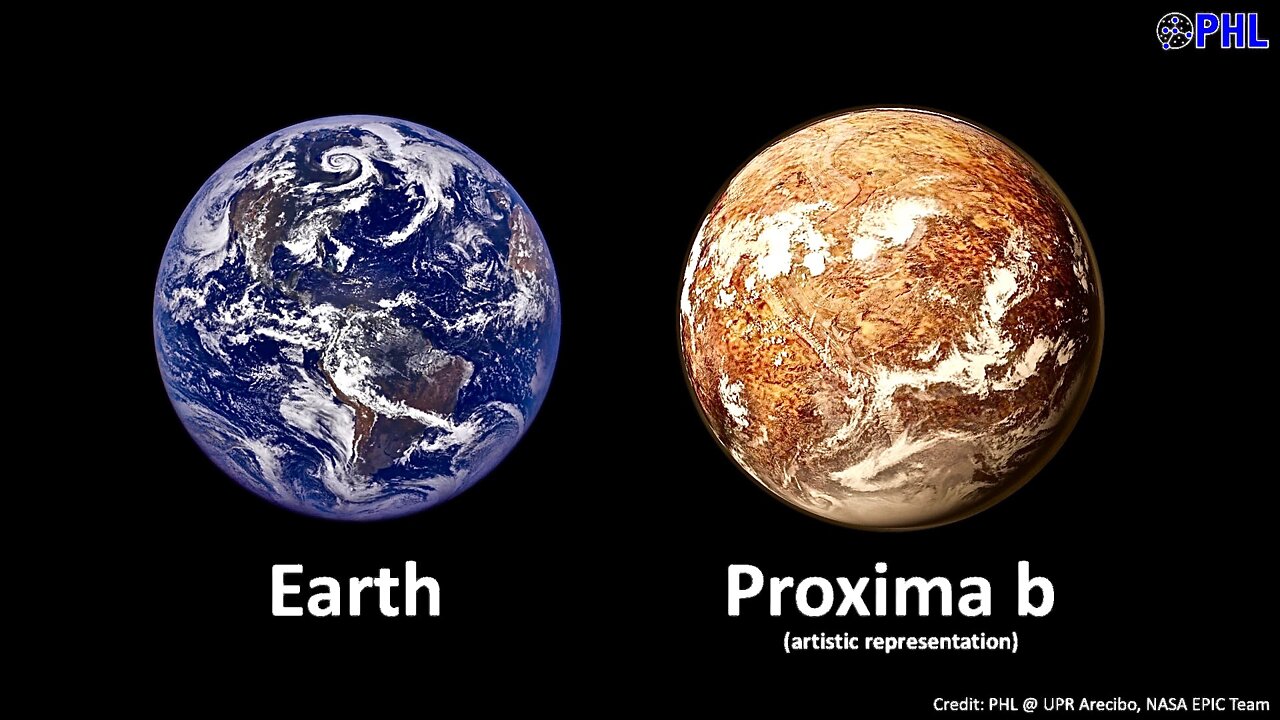Premium Only Content

New Earth Like Planet Discovered - "Proxima B" - Orbiting Our Nearest Star
Proxima b orbits the closest star to our sun – a red dwarf known as Proxima Centauri, which lies 4.2 light years away. It's a rocky, terrestrial planet with a surface -- unlike a gas giant, such as Jupiter -- that is 1.3 times the size of Earth and orbits its star every 11.2 days. It is in a close orbit of Proxima Centauri: only 5% of the distance between the Earth and the sun. They are even closer together than Mercury and the sun. But because its star is much cooler and fainter than our sun, Proxima b has a temperature that is suitable for liquid water to exist on the surface without evaporating.
Researchers estimate that if the planet has an atmosphere, which could be assumed but isn't known, it may be between 86 to 104 degrees Fahrenheit (31 to 40 degrees Celsius) on the surface. Without an atmosphere, it could be -22 to -40 degrees Fahrenheit (-30 to -40 degrees Celsius). To put that in perspective, Earth would be -4 degrees (-20 degrees Celsius) if it didn't have an atmosphere, Reiners said.
Given the proximity to its star, Proxima b is also subject to less pleasant factors like ultraviolet and X-ray flares that are 100 times the intensity of what Earth receives from the sun. In the paper, researchers estimated it to be 400 times the intensity, but recent research has caused them to create a new estimate, they said. If there is life on the planet, it would be affected by this radiation, but it is pure speculation as to what kind of effect.
We don’t even know for sure that Proxima b is a rocky planet, although researchers think this is likely, judging by other planets orbiting small stars. What we do know is that it is within the so-called “habitable zone”, meaning that if water is present on the planet, it could be in liquid form. But many important questions are as yet unanswered. We don’t know if the planet has water, or an atmosphere, or a magnetic field to shield it from the high-energy radiation emitted by its star. What is likely is that the newly discovered planet is “tidally locked” to its star, meaning that only one side receives sunlight. Proxima b might be within the habitable zone, but whether it could host life is quite a different matter.
How many other similar planets could be out there?
Thousands of exoplanets – planets outside our solar system – have been found to date. The first confirmed discoveries were in 1992, when astronomers found planets orbiting a type of neutron star known as a pulsar. The first planet orbiting a sun-like star was discovered in 1995. Since then, missions such as the Kepler space observatory, as well as ground-based observations, have found many more, including a number of Earth-sized worlds within the habitable zone of their stars. But that’s just the tip of the iceberg. Based on Kepler’s results, astronomers have suggested there could be as many as 40bn habitable, Earth-sized planets in our galaxy, travelling around red dwarfs or stars similar to our sun (yellow dwarfs). But with Proxima Centauri our nearest stellar neighbour, none of these planets would be as close as Proxima b.
Will anyone from Earth ever get near it?
That’s unlikely, to say the least. Using current technology, it would take around 70,000 years for a probe to reach the planet, although emerging technology could halve that. Further, ambitious projects, such as Yuri Milner’s $100m Breakthrough Starshot initiative, plan to create miniature space probes that would be propelled by light beams and travel at speeds of up to 100m mph, meaning that it could reach Proxima Centauri within a matter of decades.
Is the newly discovered planet part of a solar system like ours, with a group of other planets?
We don’t yet know. Scientists say they have also spotted a second, weaker signal, but it is too early to say whether that could be another orbiting body.
Do astrophysicists think there is life elsewhere in the universe?
Most seem sanguine – but whether or not there is, has been, or ever will be life on Proxima b remains a mystery, for now at least.
Music: Dream Walking (Emerald Mix) by Dhruva Aliman
Amazon- https://amzn.to/2Mgr7pg
https://music.apple.com/us/artist/dhruva-aliman/363563637
https://dhruvaaliman.bandcamp.com/album/the-wolf-and-the-river
http://www.dhruvaaliman.com/
Spotify - https://open.spotify.com/artist/5XiFCr9iBKE6Cupltgnlet
-
 49:45
49:45
Knowledge Land
10 months agoFuture War Technology - Armies of Tomorrow
400 -
 47:13
47:13
PMG
17 hours ago"Hannah Faulkner and Doug Billings | WHY LIBERALS LOST THE ELECTION"
1.21K -
 59:01
59:01
The Liberty Lobbyist
4 hours ago"We Only Have NOW To Make a Difference"
9.97K2 -
 4:16:41
4:16:41
CatboyKami
5 hours agoStalker 2 Blind playthrough pt1
6.7K1 -
 1:06:27
1:06:27
Russell Brand
5 hours agoNeil Oliver on the Rise of Independent Media, Cultural Awakening & Fighting Centralized Power –SF498
171K257 -
 1:39:14
1:39:14
vivafrei
5 hours agoSoros Karma in New York! Tammy Duckwarth Spreads LIES About Tulsi Gabbard! Pennsylvania FLIPS & MORE
80.1K64 -
 1:57:36
1:57:36
The Charlie Kirk Show
5 hours agoInside the Transition + The Bathroom Battle + Ban Pharma Ads? | Rep. Mace, Tucker, Carr | 11.21.24
129K53 -
 59:20
59:20
The Dan Bongino Show
8 hours agoBitter CNN Goes After Me (Ep. 2375) - 11/21/2024
850K3.52K -
 57:28
57:28
TheMonicaCrowleyPodcast
3 hours agoThe Monica Crowley Podcast: Mandate into Action
16K2 -
 1:02:09
1:02:09
TheAlecLaceShow
5 hours agoGuests: Alex Marlow & Terry Schilling | Justice For Laken Riley | Russian ICBM | The Alec Lace Show
31K8